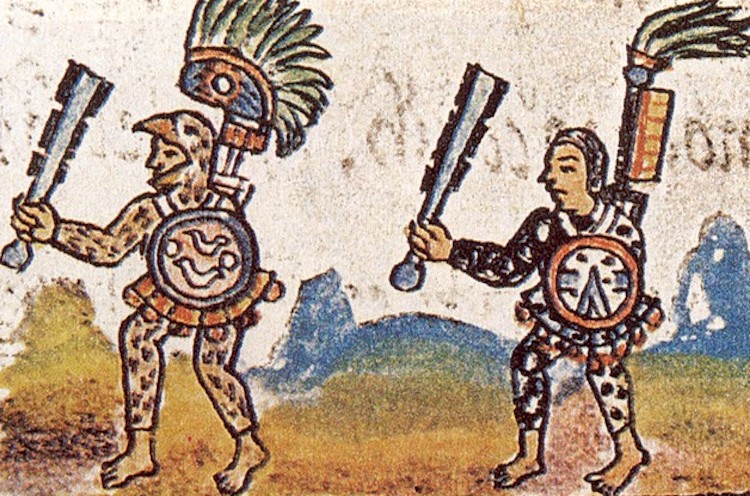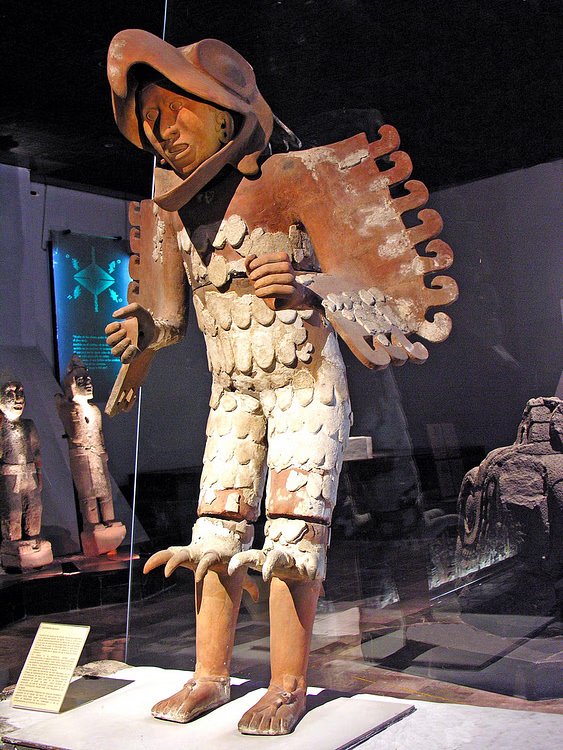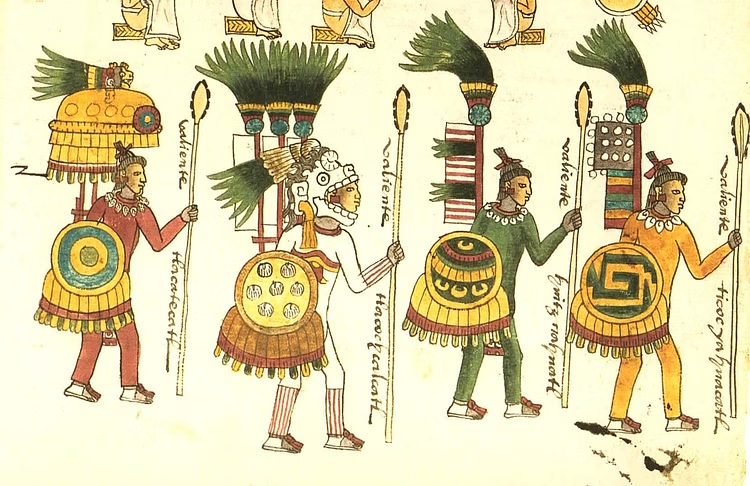


 Source: History Hit
Source: History Hit
War was central to Aztec culture, and warriors held a special position within Aztec society. Warfare was essential to keeping the empire strong, capturing new lands, gathering resources and taking prisoners captive for either slavery or sacrifice. The warriors were highly trained and ferocious in battle to achieve military success. Read through the resources below to learn more about the warrior class in Aztec culture and the weapons they sued in war.
Aztec warriors served the ruler of the empire. In the Aztec Empire, warfare contributed to both political purposes as well as ritual purposes. The political purpose was to defend the empire as well as expanding it. The ritual purposes supported the belief of the Aztec gods; it was believed that the gods granted the Aztec rulers the right to rule. After battles to appeal to the gods, the warriors would sacrifice prisoners. The Aztecs were almost always in war, so that meant there were many prisoners, especially since it was encouraged to capture others. Warfare brought power and much wealth to the Aztecs, the wealth helped pay for the updates they had to their magnificent capital city. This article discusses the role of the military and warriors in Aztec society.
The Aztecs engaged in warfare (yaoyotl) to acquire territory, resources, quash rebellions, and to collect sacrificial victims to honour their gods. Warfare was a fundamental part of Aztec culture with all males expected to actively participate and battle, referred to in Nahuatl poetry as 'the song of shields', was regarded as a perpetual religious and political necessity. The Aztecs were so accomplished in combat that they eventually forged an empire which covered 200,000 square kilometres and, at the height of their power, they extracted tribute from 371 city-states across 38 provinces. This article discusses Aztec warfare in-depth, including the weapon and armour they used and the role it played in Aztec mythology.
This article talks bout the size of the Aztec army and how it was organised. It also includes links to descriptions of some of the weapons Aztec warriors used in battle.
The Aztec Empire maintained its supremacy by war or threat of war against its neighbouring areas. Aztecs engaged in war for two primary reasons: for conquest to reap tribute or to take captives for religious sacrifices necessary to satisfy the gods. War, therefore, was a major part of Aztec society and successful Aztec warriors received high honours. This article looks at the reasons behind warfare in the Aztec Empire, the training of soldiers and military tactics.
Aztec society was a stratified system in which each social class had a role designed to support the Aztec military or what they used to call, Aztec warriors. The Aztec society had a strong central government which was supported by the military. This the reason why the military were one of the top classes on the social ladder, they came after the emperor and the religious priests. This article looks at the role the military played in Aztec society, and describes some of the most famous Aztec battles.


An almost life-size terracotta Aztec Eagle Warrior, one of the elite warrior groups in the Aztec military. 13-15th century CE, from Tenochtitlan. (National Museum of Anthropology, Mexico City)

Aztec warriors in typical costume of elite ranks with back racks displaying group insignia. They each carry an obsidian-bladed spear. From the Codex Mendoza, folio 67. (Bodleian Library, Oxford)

Franciscan friar Bernardino de Sahagún recorded this text in the mid-16th century as part of an effort to gather information about native Aztec history and customs. Sahagún went to Mexico in 1529 as one of the first missionaries assigned to the newly conquered territory of New Spain. He remained there until his death, preaching and instructing youth in Spanish, Latin, science, religion, and music. He acquired mastery of the Aztec language and collected information to help missionaries and government officials convert the indigenous people to Christianity.
The 12-volume manuscript included text, illustrations, and a grammar of the Aztec language. Completed in 1569, authorities in Spain did not want the work published in New Spain for fear of encouraging the continuation of indigenous practices. It was first published in 1829 as Historia General de las Cosas de Nueva España with an English translation in 1831.
The document illustrates elements in the socialization of boys who were among the nobility, whose way of life and culture by the time of Sahagún had been irrevocably altered by Spanish rule and the influence of the Catholic missionaries. Other passages in this book of the Florentine Codex refer to values such as chastity for boys as well as girls, the civic duties and roles of a ruler, and other personal virtues.
Click the link above to access this document.

Among the arsenal of Aztec weapons were obsidian-bladed swords and an array of clubs, bows and arrows and spears. Perhaps the most prestigious was the spear thrower known by its Nahuatl name atlatl and used to hurl lethal darts. This fine example still preserves traces of paper-thin hammered gold foil that was applied over both the front and back, and the beautifully worked supine body of a warrior carved along its length. It was probably intended for display and may have been part of a suite of ceremonial regalia proclaiming the role and status of the 'warrior king'. The warrior thrusts a spear with a pointed tip in front of him; just above the spear head, the head and two-forked tongue of a rattlesnake can be seen. The snake imagery refers to the ability of the owner to strike at a distance and was likened to the deadly lunge of the rattlesnake.

